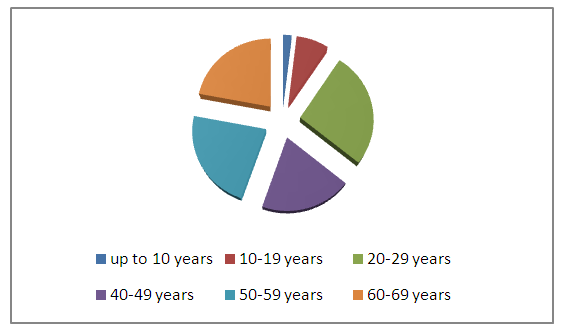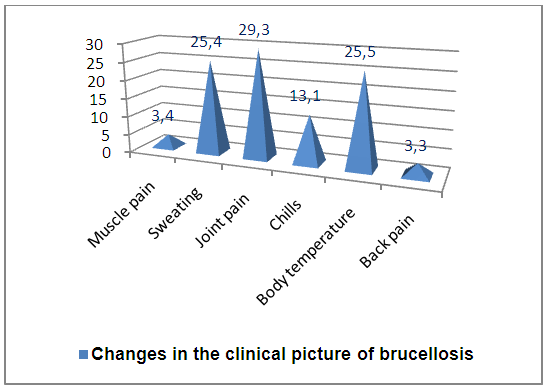-
Paper Information
- Next Paper
- Previous Paper
- Paper Submission
-
Journal Information
- About This Journal
- Editorial Board
- Current Issue
- Archive
- Author Guidelines
- Contact Us
American Journal of Medicine and Medical Sciences
p-ISSN: 2165-901X e-ISSN: 2165-9036
2021; 11(3): 228-230
doi:10.5923/j.ajmms.20211103.14
Received: Feb. 26, 2021; Accepted: Mar. 17, 2021; Published: Mar. 28, 2021

Modern Aspects of the Clinical and Epidemic Process of Brucellosis
M. A. Farmanova, S. G. Xudoydodova
Department of Infectious Diseases and Epidemiology, Bukhara State Medical Institute Named after Abu Ali Ibn Sina, Uzbekistan
Copyright © 2021 The Author(s). Published by Scientific & Academic Publishing.
This work is licensed under the Creative Commons Attribution International License (CC BY).
http://creativecommons.org/licenses/by/4.0/

Epidemiological procedure, clinical-specific brucellosis in physiological and excretory criteria and prognostic criteria. In the analyzed morbidity, patients and 86 hot tubes with impedance were studied, guarantee rejection, an infectious disease, rotting and characteristic, severe brucellosis.
Keywords: Brucellosis, Epidemiology, Clinical manifestation, Organopathology
Cite this paper: M. A. Farmanova, S. G. Xudoydodova, Modern Aspects of the Clinical and Epidemic Process of Brucellosis, American Journal of Medicine and Medical Sciences, Vol. 11 No. 3, 2021, pp. 228-230. doi: 10.5923/j.ajmms.20211103.14.
Article Outline
1. Introduction
- Brucellosis has been and remains one of the urgent problems among zoonotic infections for the health authorities of several states, including the republics of Central Asia and Uzbekistan, there is an uneven distribution of brucellosis in different regions, which depends on climatic and geographical conditions, it is one of the main factors influencing on the occurrence and development of episodic and epidemic processes. The epidemiological and epizootological situation of brucellosis remains a complex socio-economic problem. The true picture of its prevalence is difficult to assess. According to WHO (1997), more than 500,000 cases of brucellosis in humans are recorded annually in the world; estimated number is 10-25 times more. In endemic countries, the incidence rate exceeds 10 cases per 100,000 population. The high medico-social and economic significance of this disease is determined by the peculiarities of the course with the development of chronic forms, long-term disability, disability, as well as the main affected contingent - the able-bodied population aged 20 to 60 years, which is associated with social reasons and professional factors [1,3,7]. Each economic region of Uzbekistan has its own characteristics and this, undoubtedly, plays a role in the development of an episodic, and therefore an epidemic process in brucellosis. So, for example, in the Zarafshan economic region, natural conditions are different and depend on the climatic and geographical location of the territory — in the western part there are plain spaces, deserts, steppes; in the east, the area gradually passes into the foothills and mountains of the Turkestan, Zarafshan and Gissar ranges. Deserts extend southward and pass into the steppes of Karshi, Karnap-Chul, and Jazam. These are pasture lands for Karakul sheep. In the Republic in the Zarafshan economic region, the highest incidence of brucellosis has been observed for several decades. A high incidence is also noted in the Jizzakh region, belonging to the Tashkent economic region, but it should be emphasized that earlier the Jizzakh region was part of the Samarkand region as one of the regions. In these territories, historical prevailing episodic brucellosis troubles are observed associated with the livestock orientation of agriculture, as More than 60% of agricultural animals are located in these territories. Here, the astrakhan farms of Uzbekistan are concentrated, as well as the very high weight of livestock belonging to the private sector.In the indicated territories of the Republic, the intensive incidence rate of brucellosis exceeded in some years 24.16 (per 100 thousand people), not dropping below 3.0 even in prosperous periods. At the present stage, episodic and epidemiological situations of brucellosis are becoming more complicated due to the disbanded state farms — sheep trade farm (SHTF) and milk trade farms (MTF) [5,6,8].A new type of farm-farm was formed, the number of livestock increased, especially in individual farms. So, for example, in the Republic as a whole compared to 2004, in 2009 the number of cattle increased by almost 1 million heads, and small cattle by 5 million heads. With this type of farming, the unprotected strata of the population became even more involved in farming, i.e. minor children. And most importantly, veterinary control of animals and epidemiological surveillance of workers caring for these animals are not carried out. they are not considered a professional contingent due to the lack of SHTF and MTF.In this connection, brucellosis among the population is gradually becoming more active, cases of brucellosis have become more frequent, the disease is sufficiently recorded among children under 14 years of age, and family cases of the disease have often been observed [2,4,9].It has been established that, as we have repeatedly pointed out in our previous works, the incidence rate remains high in the former endemic regions of the Republic, among which the leading ones are the Zarafshan and Tashkent economic regions.
2. Purpose of the Study
- To identify the features of the epidemic process of brucellosis in modern conditions and to develop criteria for predicting the incidence of this pathology.
3. Materials and Methods
- When analyzing the incidence of brucellosis for 2010-2018. The data of the Republican Center for Sanitary and Epidemiological Supervision were used. An epidemiological assessment of 86 case histories was carried out with the determination of the source of the causative agent of infection, the ways and conditions of infection, the age and nature of the professional activity of patients with brucellosis in 2010-2018.
4. Results and Its Discussion
- According to the research results, in the structure of the incidence of zoonotic infections according to the long-term average data from 2010-2018. the share of brucellosis was 5% of the total amount of zoonotic infections. The distribution of incidence among regions of the republic was characterized by unevenness. In total, during the period of research in the territory on brucellosis of cattle and small cattle, 21 dysfunctional points (20%) and 51 points in the individual 98 (80%) livestock sector were registered in the public sector.It should be noted that diagnostic studies and vaccination work among animals of the individual and public livestock sector are not carried out in full.An important prognostic sign of the incidence of brucellosis among animals in the republic is an increase in the percentage of reagents (animals that respond positively to brucellosis investigated by serological methods: agglutination reaction and complement binding reaction).An increase in the percentage of reagents is observed in regions with an increased and moderate degree of incidence. According to the results of the research in rural areas, it was found that the male population prevailed in the morbidity structure (72%). Recently, there has been an increase to 87% in the share of working-age people with brucellosis. The main risk group for age in these years was people 30-39 years old (1.31 ± 0.36 per 100 thousand people). In all other groups, the incidence was: up to 10 years (0.09 ± 0.06 per 100 thousand population), 10-19 years (0.35 ± 0.11 per 100 thousand population), 20-29 years (1.25 ± 0.43 per 100 thousand population), 40-49 years (0.92 ± 0.26 per 100 thousand population), 50-59 years (1.07 ± 0.43 per 100 thousand population) and 60-69 years (1.04 ± 0.09 per 100 thousand population).
 | The main risk group by age |
 | Figure |
5. Conclusions
- 1. The clinical manifestations of brucellosis in the modern period are characterized by a milder course, a shorter duration of the prevalence of acute forms.2. In the structure of patients, the number of persons professionally not associated with animal husbandry increases, the infection of which comes from cattle in the individual animal husbandry sector.
 Abstract
Abstract Reference
Reference Full-Text PDF
Full-Text PDF Full-text HTML
Full-text HTML